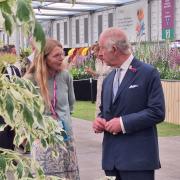Every year a special team from the Cotswolds National Landscape assesses the wildflower potential of myriad fields in the surrounding area. Although it first started advising on wildflower restoration some time ago, it has recently become increasingly overwhelmed by all kinds of people, all wanting and needing help with creating their own wildflower spaces.
And it’s not just enthusiastic gardeners and farmers who are getting in touch. Enquiries have been flooding in from schools, parish and town councils, and more. All of them beating a path to its door in a bid to get help and advice on how to grow wildflowers – not only in existing fields, but on all sorts of different land, including scrubbier areas which are harder to know what to do with but often make beautiful wildflower sanctuaries.
Despite the extra work, this is good news. Up to half of Britan’s precious ‘unimproved Jurassic Limestone Grassland’ – the most important kind of habitat for wildflowers and rare plants – lies in the Cotswolds. But, just as elsewhere around Britain, wildflower meadows in the Cotswolds have dwindled, and when in the past they may have made up as much as 40% of Cotswold land, they are now estimated to account for only around 1.5% of the area.
To redress this and upscale the amount of land put down to wildflower meadows, the CNL now offers enquirers a land management service through its Glorious Cotswold Grasslands division, set up in 2019 with the specific aim of protecting and restoring Cotswold grasslands. The service it provides is particularly helpful on large tracts of land such as farms, but it also offers aid and advice to anyone who gets in touch on either how to start from scratch or enhance what wildflowers they might already have, regardless of whether this is a small front lawn or a wide-ranging valley. It will also assist with how to manage the preparation of land for growing wildflowers and seed distribution as well as giving ongoing support.

When first starting out with your plot, it’s important to look out for any ‘wildflower indicator species’ which you might already have. These will provide you with a good guide as to what type of wildflowers will thrive in the area you have picked as well as indicating how complicated or easy the process of making a wildflower meadow will be for you.
Anna Field, GCG’s programme officer, explains: ‘We always start by carrying out a botanical survey of a new site, as the most appropriate kind of management or restoration used will depend on what you’ve already got. On the kind of calcareous grassland found on Cotswolds limestone, we would look for indicator species such as ox-eye daisy, bird’s-foot trefoil, lady’s bedstraw, salad burnet, orchid, greater knapweed, cowslip and wild thyme. Less common species to look out for might include kidney vetch, harebell, and devil’s-bit scabious. On damper, heavier soil we would look for a different set of indicator species, including meadowsweet, meadow vetchling and great burnet.
‘We also record less desirable species such as creeping thistle, spear thistle and broad-leaved dock. Although they are important food sources for invertebrates, they can crowd out delicate flowers and may need more specific management to allow the meadow to flourish,’ she adds.

With Anna’s help we undertook a botanical survey of one of our Cotswold meadow fields at home which has never been cropped, only extensively grazed by sheep. Good indicators we discovered included two types of sedges, bird’s-foot trefoil, ladies bedstraw, common sorrel and meadow vetchling.
Such valuable finds meant we were in luck. Finding a good number of indicator species generally shows that the grassland is still in reasonable condition and therefore likely to make a good site for successful wildflower meadow restoration. Plots in poorer condition, meanwhile – for example, fertile sites or those that have been previously reseeded – can be more difficult to restore. But with careful preparation and management some increase in wildflower diversity is still possible, but will probably take longer.
Lists of indicator species can be found on the Cotswolds National Landscape website at cotswolds-nl.org.uk together with advice on how to manage your own meadow for wildflowers. For those who would like more help working out a baseline, the GCG team is able to conduct a botanical survey of your land for you and can advise you on a suitable restoration and management plan. Meanwhile, Plantlife at plantlife.org.uk, founded 30 years ago as a plant conservation charity, has lots of resources available for those looking to increase wildflowers on their land.
With meadow restoration in mind, now might be the time to explore opportunities and ways of funding your wildflower meadow.
READ MORE: How to create your own wildflower meadow starting in spring



























